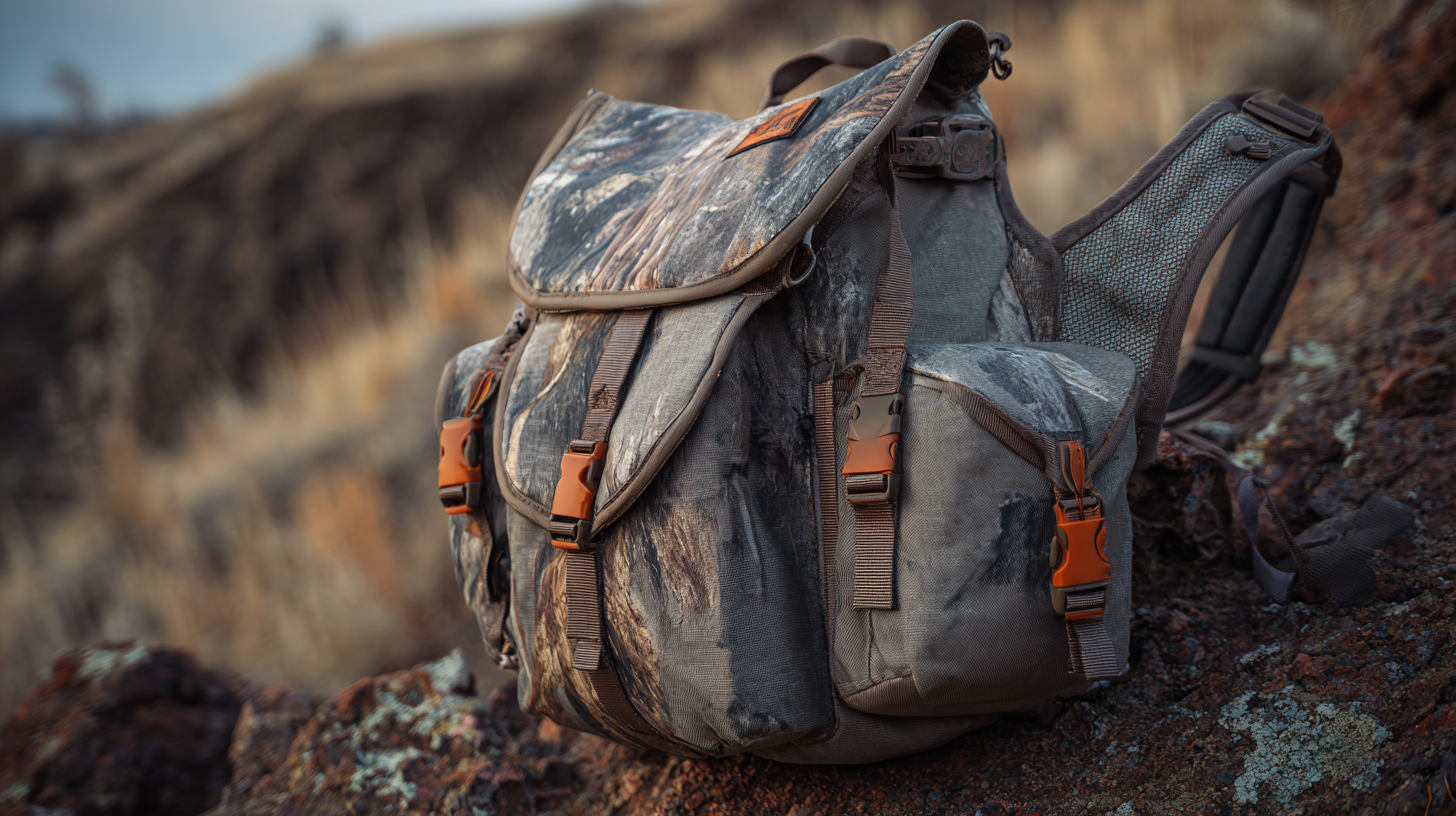Revolutionizing Outdoor Gear with Best Hunting Saddle Bag and Future Technology Trends
In the ever-evolving world of outdoor gear, the Hunting Saddle Bag stands out as a revolutionary accessory that transforms the way hunters prepare for their expeditions. This blog delves into the innovative features of the best hunting saddle bags currently on the market, exploring how advancements in technology are shaping their design and functionality. From lightweight materials to ergonomic shapes and modular compartments, the modern hunting saddle bag is not just a utilitarian item but a testament to the integration of digital trends in outdoor equipment. Additionally, we will provide valuable tips on selecting the right bag that meets your specific hunting needs while staying ahead of emerging trends. Whether you're a seasoned hunter or a newcomer to the sport, understanding these developments will enhance your outdoor experience and ensure you're well-equipped for your next adventure.
Innovative Features of the Best Hunting Saddle Bags on the Market
The hunting saddle bag has evolved significantly, incorporating innovative features that cater to the diverse needs of outdoor enthusiasts. One standout development is the integration of modular designs that allow hunters to customize their storage solutions. Many of the best hunting saddle bags now offer detachable compartments, enabling users to organize their gear more efficiently. These modular systems not only enhance accessibility but also facilitate quick adjustments according to the hunting environment, whether it’s a day trip or an extended expedition.

Another remarkable innovation is the use of advanced materials that prioritize durability while minimizing weight. Cutting-edge fabric technology, including water-resistant and tear-proof materials, ensures that these bags can withstand the rigors of the outdoors. Additionally, some saddle bags come equipped with features like reflective strips for visibility in low-light conditions and integrated hydration systems to keep hunters hydrated on the go. As technology continues to advance, the future of hunting saddle bags promises even more enhancements, ultimately transforming the way hunters engage with their gear in the wild.
The Impact of Chinese Manufacturing on Global Outdoor Equipment Quality
The impact of Chinese manufacturing on global outdoor equipment quality is profound, particularly in the context of initiatives like "Made in China 2025". This initiative aimed to transform China into a global leader in advanced manufacturing, promising improvements in quality and innovation. While the actual effect may have been overstated, evidence suggests that Chinese manufacturers have increasingly adopted cutting-edge technologies, enhancing the production of outdoor gear, including hunting saddle bags. According to a recent industry report, over 40% of outdoor equipment sold globally now originates from Chinese manufacturers, reflecting their significant influence on market standards and quality benchmarks.

Furthermore, as Chinese companies lead in developing low-carbon technologies, the implications extend beyond environmental benefits. This is crucial for the outdoor gear industry, where sustainability has become a vital concern for consumers. The integration of innovative materials and eco-friendly production processes is reshaping product offerings. For instance, a market study indicates that around 30% of consumers prioritize sustainability when purchasing outdoor gear, a trend that manufacturers are keenly responding to. Thus, as China continues to assert its manufacturing prowess, the quality and sustainability of outdoor equipment are likely to see substantial advancements, shaping the industry's future landscape.
Emerging Tech Trends Shaping the Future of Hunting Gear
The rapid advancement of technology is significantly shaping the future of hunting gear, particularly with the integration of smart features in essential equipment. Emerging tech trends like IoT (Internet of Things) and AI (Artificial Intelligence) are enhancing the functionality and user experience of outdoor gear. For instance, hunting saddle bags are now being designed with built-in GPS systems and smart compartments, allowing hunters to keep track of their gear and stay organized in the field.
When selecting a hunting saddle bag, consider opting for one with modular compartments. This feature allows for customization based on your hunting style and the type of game you're pursuing. Additionally, look for lightweight materials that offer durability and weather resistance, ensuring your gear withstands the elements while remaining easy to carry.
As we embrace smart technology, hunters can also benefit from gear that features integrated sensors to monitor environmental conditions like temperature and humidity. This information can be invaluable in planning outings and enhancing your chances of a successful hunt. By staying attuned to these tech trends, hunters can revolutionize their outdoor experience, making it not only more efficient but also more enjoyable.
Sustainability in Outdoor Gear: A Look at Eco-Friendly Materials
In recent years, the outdoor gear industry has witnessed a significant shift towards sustainability, driven by both consumer demand and environmental necessity. According to a report by Allied Market Research, the global sustainable outdoor apparel market is projected to reach $15.5 billion by 2025, growing at a CAGR of 9.4%. This growing market trend is compelling manufacturers to innovate with eco-friendly materials, such as recycled polyester and organic cotton, which reduce waste and minimize the carbon footprint.
Moreover, advancements in technology are enabling the development of high-performance materials that prioritize sustainability without compromising quality. For instance, brands are increasingly utilizing advanced manufacturing processes that enhance durability while using less water and energy. A survey conducted by the Outdoor Industry Association found that 57% of outdoor consumers are willing to pay more for sustainable products, highlighting a shift in consumer values. As the industry embraces eco-friendly practices, hunting saddle bags and other outdoor gear are becoming not only functional but also environmentally responsible, reflecting a commitment to preserving the natural landscapes that enthusiasts cherish.
The Role of Consumer Feedback in Shaping Modern Hunting Accessories
In the modern hunting accessories market, consumer feedback is playing a pivotal role in driving innovation and shaping product design. Reports indicate that nearly 80% of outdoor enthusiasts rely on online reviews and user testimonials when selecting gear, highlighting the importance of consumer opinions in this industry. This trend has become instrumental for brands looking to align their offerings with actual user experiences, particularly in categories like hunting saddle bags, where functionality and practicality are paramount.
Moreover, as technology evolves, so does the expectation from consumers for smart gear equipped with features such as GPS tracking and built-in hydration systems. According to a recent survey, over 65% of hunters expressed interest in accessories that integrate technology for enhanced convenience. This shift not only reflects a growing demand for advanced functionalities but also emphasizes the necessity for manufacturers to actively seek and incorporate consumer insights into their development processes. By doing so, they can ensure their products meet the diverse needs of the hunting community while paving the way for future innovations.
Trends in Consumer Feedback for Hunting Saddle Bags
This chart illustrates consumer satisfaction ratings for various key features of hunting saddle bags. The ratings reflect the importance of durability, comfort, storage space, weight, price, and design based on consumer feedback. Understanding these preferences is crucial for manufacturers as they innovate and enhance their products in response to market demands.

Home
About Us
Products
FAQ
News
Contact Us






 Hunting And Shooting Bag LSH
Hunting And Shooting Bag LSH Tactical Military Bag & Vest LST
Tactical Military Bag & Vest LST Archery Bag LSC
Archery Bag LSC Fishing Bag LSF
Fishing Bag LSF Others LSB
Others LSB

